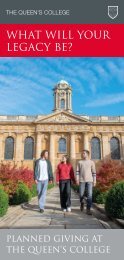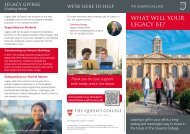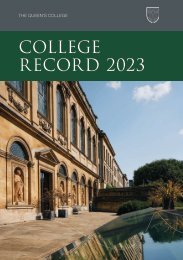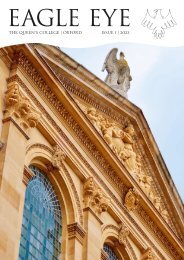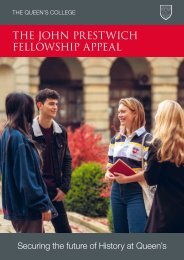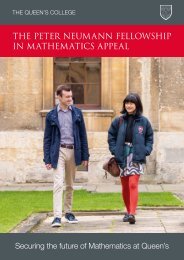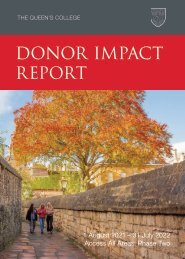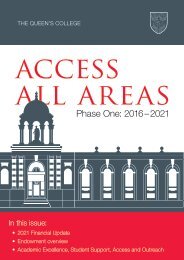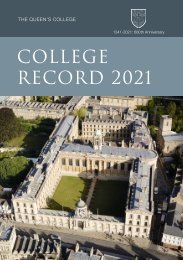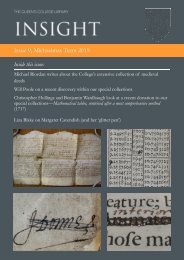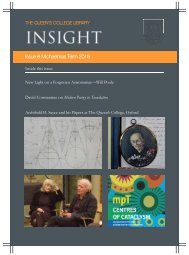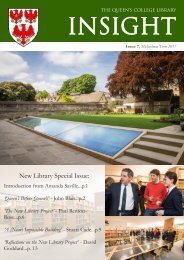The College Record 2022
You also want an ePaper? Increase the reach of your titles
YUMPU automatically turns print PDFs into web optimized ePapers that Google loves.
Obituaries<br />
pilgrimage more generally, as well as in medieval art and architecture, particularly<br />
of France and Italy, which always informed his work, and for which frequent family<br />
holidays provided much source material. <strong>The</strong> Sepulchre of Christ is the third of<br />
Colin’s major and transformative books. <strong>The</strong> first, <strong>The</strong> Discovery of the Individual,<br />
1050 – 1200 (1972) was truly ground-breaking, inspirational, and controversial, for<br />
it convincingly challenged the Burckhardtian orthodoxy (still often believed!) that it<br />
was only with the Italian Renaissance that the concept of the individual first emerged<br />
in the European West. As a reviewer wrote in 1975, ‘every future exploration of this<br />
subject will have to begin right here’: it still does! <strong>The</strong> Papal Monarchy: the Western<br />
Church 1050 – 1250 (1989) is a massive, beautifully written (as were all his works),<br />
analysis of developments across the Western Church set against the background of<br />
emerging papal power, and the growing centralization of ecclesiastical authority. <strong>The</strong><br />
book was long in the making, for it deploys an extraordinary range of material, both<br />
primary and secondary, and makes detailed use of work in an impressive number<br />
of European languages, in which Colin was fluent (he also published in German, and<br />
was a frequent reviewer of works written beyond the Anglophone sphere).<br />
Following his retirement, he continued to live in Southampton. As a lecturer on<br />
Viking cruises, he was enabled to travel widely including the Baltic, Eastern Europe,<br />
Scandinavia, and the Mediterranean which enjoyably enriched his post-retirement<br />
research. This included a series of articles primarily but not exclusively, on the<br />
crusades, as well as two books, Pilgrimage: the English Experience from Becket<br />
to Bunyan, an edited volume to which he made a substantial contribution, and<br />
<strong>The</strong> Sepulchre of Christ. Between 1998 and 2000 he served as President of the<br />
Ecclesiastical History Society, and was elected FBA, in 2007. In 2009 he was made<br />
an Honorary Fellow of the <strong>College</strong>.<br />
Almost to the end of his life he remained, what he had always been, a most convivial<br />
raconteur, with a lively sense of humour. He retained a strong interest both in the<br />
research of others, and in his own. Though sadly affected by dementia towards<br />
the end of his life, the last time I saw him we were able to discuss the Cistercians<br />
in twelfth-century France, and their abbeys, many of which he remembered and<br />
knew well, and in his very last days he was still trying to articulate new thoughts on<br />
crusading warfare.<br />
At his funeral, Colin’s son summed up the principles by which his father lived: ‘Be kind,<br />
be truthful, be curious’. <strong>The</strong>re is no better testimony to his life and scholarship.<br />
Brian Golding<br />
120 <strong>The</strong> Queen’s <strong>College</strong> | <strong>College</strong> <strong>Record</strong> <strong>2022</strong>






